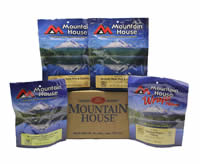Survival Food Storage Packaging
What’s the difference?

Most food storage providers offer two different types of long term Survival Food packaging, the shorter shelf-life “cook in pouch” meals and the longer term variety that is stored in larger mylar bags or #10 cans.
All long-term food storage is packed in Mylar bags or #10 cans with oxygen absorbers added. The larger, more reputable providers use a nitrogen flushing system when packing their product to ensure all of the oxygen is gone before sealing.
The biggest difference between the 25 year food storage and cook in pouch meals is the thickness of the mylar bag that is used in the packaging process, unless they are canned. One package you pour water into the pouch, and the other longer life packages you pull your food from the pouch or can and cook it in a separate container.

There is no difference in how the food tastes. In fact, the only real difference is that you will usually see slightly larger serving sizes in the cook in pouch meals, which I assume is due to their extensive use by campers and hikers.
Cook in pouch containers are most commonly found in the 3 – 7 day emergency kits and typically have about half the shelf life (usually 7 -10 yrs.) than the foods packaged in the thicker Mylar bags and cans.
Most 25 year food storage is packed in 10 – 12 serving size Mylar pouches or cans. One disadvantage to these larger serving containers is that you may find yourself only needing to cook a portion of the food in each container.
Therefore, you need to reseal the rest in a zip-lock bag or other airtight container. The newest marketing trick is the promotion of the re-sealable mylar bags, which is pretty handy, however useless in the inference that it allows you to extend the life of the food storage, once air hits any food storage you are on a 10 – 15 day clock for spoilage.
I have to admit that I like the cook in pouch meals better based on their ease of use. However, they are also much more expensive and should be just a small fraction of the overall picture when long term food storage planning.
You can always pick up and add some “emergency cook in pouch kits” to your long term food storage preps from time to time. You can find these small kits on sale everywhere, online retailers use them as loss leaders to attract larger purchasing buyers.
This way, you have the ease and comfort of the “cook in pouch” bags for short term emergencies and the larger Mylar bags to use for extended emergency situations.
Note: If you are preparing a bug-out strategy, I highly advise that you consider the “cook in pouch” solution for bugging out, unless your bug-out location has a fairly easy place to prepare meals.

The biggest brouhaha in packaging revolves around #10 Cans vs. Mylar bags inside of Buckets. Two of the three companies we carry use Mylar bags inside of buckets (Legacy and Wise) and Mountain House uses #10 cans inside of boxes.
The world’s largest freeze dried food producer, Mountain House, packages all of their long-term food in #10 cans (coffee cans) with re-sealable plastic lids. The world’s largest survival food storage company, Wise Company Foods, packages all of their products inside of re-sealable Mylar bags, this has become the industry norm
The physical difference between the buckets and cans is obvious; however, in study after study after study after study …. (a lot of studies) at least one study per year, Mountain Houses’ canning process proves itself to be superior in the amount of oxygen that is allowed to seep into the food over time. In fact, they have never lost in this comparison test verses mylar bags.
With that being said, I wouldn’t let that influence my decision. If you are buying from a reputable company that nitrogen flushes their products prior to packaging, the difference is minimal. The real difference will be on year 30 after the mylar bags are out of date by 5 years. If you decide to eat some expired stock … this is where you would rather have the cans.

Mountain House regularly opens 30 – 40 year old cans of food to prove that they are still edible. In fact, they are the ONLY food storage company that can open a 25 year old sample to prove that their food is still good to eat after 25 years. Every other company is still measuring 5 – 10 year old samples and doing the math to back up their claims.
But, the math s pretty solid. Basically they measure the amount of oxygen that is allowed to seep into a mylar bag over a measured time frame. Once they get these readings they can usually accurately predict how long the food will remain edible.
Other things to consider is the container’s practicality and after-life usefulness.
For instance, if you are in a bug-out situation you may want to lean towards the buckets due to the fact that they are easily carried and stacked. Buckets stack vertically as opposed to horizontally, so they take up more ceiling space than real estate. It’s also VERY nice to have 4 gallon buckets left for other valuables or for water or sanitary uses.
However, if you are “bugging in” and you don’t plan to bug-out, you may want to consider the #10 cans sold by Mountain House. All of MH’s long-term food comes in stackable #10 cans with re-sealable plastic lids stacked into boxes.
Bottom line, stock Corvettes are faster than stock Mustangs … both are pretty dang fast … take your pick.

